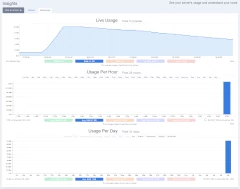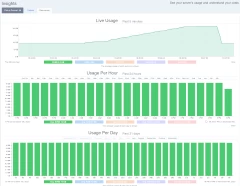Servers on Slicie scale automatically!
Try it free for 60 days at slicie.com
Why Automatic Scaling?
It's easy and powerful
Automatic Scaling makes your life easier by monitoring your server's usage in real-time and scaling it up and down to meet changes in demand. Our algorithms find the optimal balance between performance and cost, allowing you to rest easy knowing that your websites are running smoothly and you're saving money.
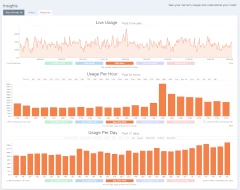
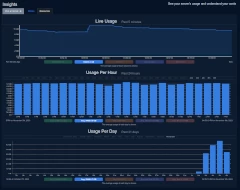
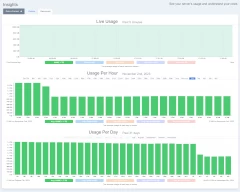
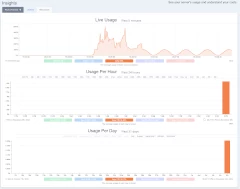
It's hard to pick the right hosting plan
On a hosting plan, you choose the limits you're willing to pay for. Even if you're on an "unlimited" plan, there are still limits within your Terms of Service (no one's running a hosting business to lose money).
Let's take it for granted that you fully understood every resource your web host was selling you; your application's needs change with demand constantly. Your web hosting company likely has graphs showing your usage, but those hide the problem by displaying your usage averaged over time.
Here's a graph from our customer portal of a web hosting server running cPanel with a few hundred websites. This image shows the average CPU usage each day for the past month.
What size web hosting plan would you need to run this server? On the 25th, it appeared to use almost exactly one vCPU (100%). The highest it used was about 140%. Which plan would you buy, one with one or two vCPUs? If you paid for a plan with two, you'd be wasting a lot of your CPU most of the time.
Check out this graph; it's from the same server on the 17th (from the previous graph).
That paints a different picture. We see that, on average, we were using over 200% at 6 PM and about 100% at 11 PM. By showing more precision, we see that if we picked a plan with two vCPUs, we'd have run out of CPU at 6 PM.
Think about that for a moment. We know that, from our first graph, we averaged just 142% of the CPU on the highest day of usage in the past month... but to not run out of CPU, we'd need to buy at least three vCPUs.
Here's the thing: the problem is a lot worse when you look even closer. Take a look at the following graph. This graph shows the live usage, tracked every second in our customer portal.
The usage shown in the graph above is normal; this is just the usage as I sit here writing this on a shared hosting server. The graph shows the usage today at 11 PM, where the average for the entire hour is 96% (just below one single vCPU). We're not showing the worst-case scenario; these fluctuations in usage are constant occurrences in web hosting, and this graph depicts those fluctuations in off-peak hours.
So, let's ask the original question again based on all these graphs. What size web hosting plan would you need to run this server? We can see from the most precise graph that this server spikes to nearly eight vCPUs in off-peak hours. Based on this information, any hosting plan smaller than eight vCPUs will hurt performance (and who knows what the peak was during the other hours).
You don't have a hosting plan on Slicie
You don't need to guess what plan is the best possible fit for your server on Slicie. Our Automatic Scaling monitors your usage every second, and it gives you more resources as you need them. When it sees your usage lowers, it takes back the resources you aren't using. Regardless of how many resources we give your server, you only pay for the ones your server winds up using.
Paying for what you use is cheaper than paying for a limit
Imagine that you picked a line at the top of the graphs previously on the page, and that was going to be your hosting plan limit. Everything in between your hosting plan and what you actually used would be wasted money. On Slicie, because you only pay for what you use, that is the area of the graph where you're saving money compared to a hosting plan.
The graph above shows why you can't simply compare our pricing to a hosting plan: you aren't paying for the same thing. We're not selling limits, and you aren't able to truly use your hosting plan's limits. Realistically, if you want to have decent performance on a hosting plan, you'll need to pay for 5-10x what you actually use on average. The truth is, we see people using about 5% of their hosting plan's CPU limit, which means for every 20 dollars they spend on hosting, they only used about a buck.
Hosting plan limits hurt your wallet
The Opportunity Cost
Imagine you're running a succesful e-commerce site. You're paying $150/mo in web hosting and taking in $25k/mo in revenue for your business. Your web hosting costs about 0.6% of the revenue you bring in, which is fairly common for self-hosted ecommerce stores. The problem is, this means that when your hosting performs poorly, it has a very high cost on your revenue. For instance, even if your web host compensates 100% for downtime by giving you an account credit of $5 for a one day outage (one 30th of your monthly bill), you lost $833 in revenue. This is known as "opportunity cost", and it's a serious problem with web hosting plans.
You're probably thinking, "well yeah, no kidding, you have to accept some risk in running an online business and you need a big enough hosting plan". We agree, and we see businesses upgrade their hosting plans all the time because of a promotion that crashes their website! They're so afraid of wasting money on ads that result in downtime that they "future proof" their hosting plan. Even though their average CPU usage might be 1 single core, they end up on machines with 32 cores or more, to try and keep their hosting limits from hurting their revenue.
The Headache
A server running poorly is the biggest complaint of developers. It's a relentless struggle between server admins (and web hosts) and software developers. One side accuses the other, and neither has the expertise to understand the complexities on the other side. You can bet that every second, a developer is blaming their web host... and some of the time, they're right. If you're a business owner, this constant headache is costly, and if you're a developer, it's a pain in your butt.
